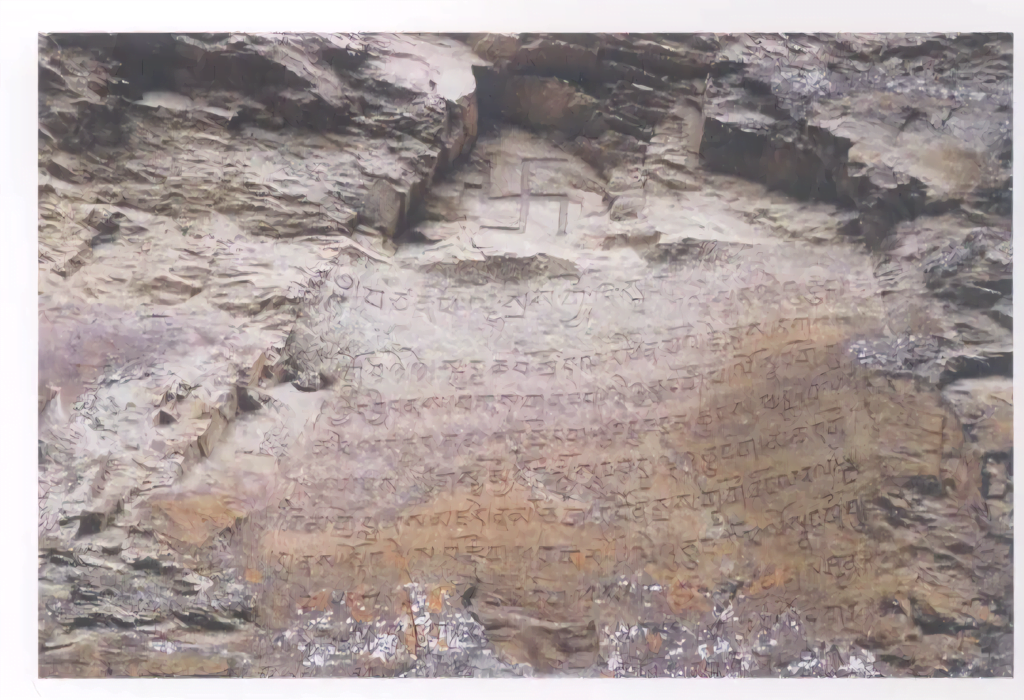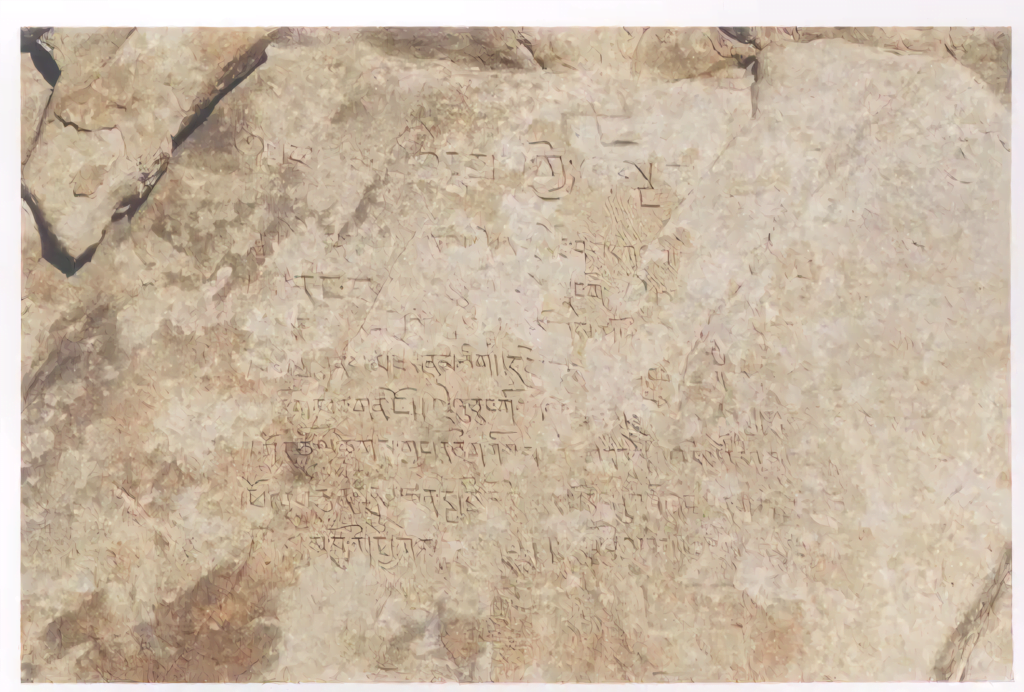Located near the village of Deyu longzeng in Guangjiu Township, southwest of Nyingchi, Tibet, and facing the majestic Yarlung Tsangpo River, the Tubo Gongbu Cliff Inscription, also known as the “Dêmu Sa Cliff Inscription,” holds a revered place in Tibetan history. Perched just 300 meters southwest of the village and south-facing, this historical monument, backed by the sacred Bonri Mountain, has been a silent witness to over 1200 years of history.
A Covenant Set in Stone
The Tubo Gongbu Cliff Inscription is a testament to the ancient Tibetan script, carved in the late 8th century. It commemorates the alliance oath taken between Tubo King Trisong Detsen and the tribal chiefs of the Gongbu region. The inscribed stone stands at 2.6 meters tall and 1.48 meters wide, containing 21 lines of text alongside a column of the “Swastika” (Yungdrung) symbol, showcasing the rugged elegance of ancient Tibetan calligraphy.
The inscription narrates the shared lineage between the Tubo king and the Gongbu chiefs, tracing back to the progenitor, Nyatri Tsenpo, described as “the son of the gods of good fortune.” This account aligns with ancient Tibetan manuscripts from Dunhuang, suggesting the royal roots of the Tubo dynasty in indigenous traditions. It delineates the division of land and the shared ancestry, establishing the Gongbu Mangpoje as close kin to the Tubo royal family and affirming their dominion over slaves, farmlands, and pastures, alongside their devotion to the local deities.
Legacy of a Mighty Era
Under King Trisong Detsen’s rule, the Tubo kingdom witnessed unparalleled prosperity, marked by significant advancements in Buddhism, including the construction of the Samye Monastery and the ordination of monks. His military campaigns expanded the Tubo influence across vast territories, including a brief capture of the Tang capital, Chang’an. The inscription also reflects the social, economic, and political structures of the time, highlighting the imposition of tribute and taxes, as well as the continuation of alliances and the preservation of native religious practices.
The Tubo Gongbu Cliff Inscription offers invaluable insights into the complexities of the Tubo dynasty, providing a rich narrative of its economic, political, and cultural landscape. This ancient relic not only captures the essence of a bygone era but also stands as a profound piece of Tibet’s historical puzzle, making it an essential study for those seeking to understand the ancient kingdom’s legacy.
Visiting Tips
- Location: The Tubo Gongbu Cliff Inscription is accessible from Bayi Town, located about 30 kilometers away, offering visitors a chance to delve into the depths of Tibet’s rich history.
- Historical Context: The Tubo dynasty, emerging around the 4th century BCE, unified the Tibetan plateau under King Songtsen Gampo, establishing a powerful slave society with Lhasa as its capital. The era of Trisong Detsen represents the zenith of Tubo’s power, with significant contributions to Tibetan Buddhism, culture, and governance.

Exploring the Tubo Dynasty: Insights into Tibet’s Golden Era
The Tubo Dynasty, emerging around the 4th century BCE in the Yarlung Zangbo River region, marked the rise of the first powerful empire on the Tibetan plateau. Nyatri Tsenpo, known as the inaugural ruler, unified several smaller states to form a formidable confederation. By the 7th century, under King Songtsen Gampo, the empire expanded its territory, encompassing areas such as Tö, Gongbo, Nyanang, Zhangzhung, and Subi, establishing Lhasa as its capital and laying the foundations of a significant slave society.
The Zenith of Tubo Power
Under the leadership of Trisong Detsen in the mid-8th century, the Tubo Dynasty witnessed unparalleled prosperity. This era was characterized by internal consolidation and aggressive territorial expansion, extending its influence to the Anxi Protectorate and the Hexi Corridor, marking the height of Tubo power. However, by the mid-9th century, the assassination of the last emperor, Langdarma, led to royal schism, noble civil wars, and slave uprisings, culminating in the collapse of the Tubo slave society. From its inception, the dynasty lasted for 1,444 years over 40 generations.

Tride Songtsen: Architect of Tubo’s Cultural Renaissance
Tride Songtsen, also known as Sadnalegs, was the 38th emperor who ascended the throne in 798 CE. His reign was notable for the promotion of Buddhism, the establishment of a monastic governance system, and significant diplomatic achievements, including the first ordination of Tibetan monks and the translation of Buddhist texts. His son, Tsangma, became the first monastic member of the royal family, illustrating the deep integration of Buddhism into the Tubo royal lineage. Tride Songtsen’s efforts in diplomacy and cultural exchange with the Tang Dynasty laid the groundwork for the Tang-Tubo alliance, enriching both empires’ cultural and political landscapes.
These highlights offer a glimpse into the Tubo Dynasty’s rich history, showcasing its cultural achievements, religious integration, and the pivotal role it played in shaping Tibet’s historical trajectory.
